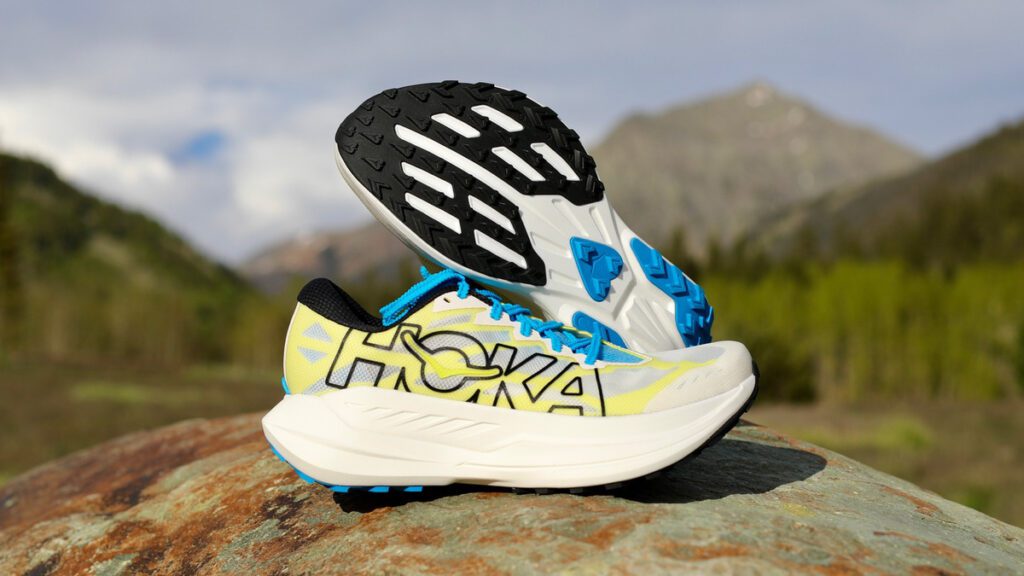Hoka has long drawn attention in the trail running community, especially since introducing their maximally cushioned footwear nearly 15 years ago, which shifted the paradigm away from a trend towards minimalism. The brand is currently riding a wave of popularity with its carbon-plated trail running shoes, most notably within their Tecton X line, which has seen enhancements over its iterations. Recently, however, they debuted a new model, the Mafate X, stacked with features aimed at handling tough trail conditions. The newcomer excels in ruggedness and durability, akin to a “carbon tank,” designed for less forgiving trails.
Insights collected from attendees at high-profile races have hinted at further advancements within Hoka’s carbon plate trail shoe offerings. Custom footwear worn by elite athletes like Ludovic Pommeret, who clinched victories at both the 2024 and 2025 Hardrock 100, showcases developments that have piqued widespread interest. Similarly, Vincent Bouillard and Fu-Zhao Xiang utilized unique features in their winning runs at the 2024 UTMB and 2025 Western States 100, raising speculations on what lay behind their performance enhancements. It has now been revealed that these shoes contain elements of the forthcoming Hoka Rocket X Trail, marking Hoka’s forthcoming entry into the dual-carbon plate category.
The Rocket X Trail is anticipated to cater to competitive runners seeking speed on non-technical gravel and smooth singletrack terrains. Initial reports from runners who have tested this shoe suggest an effective balance of cushioning and propulsion, thanks to its unique Aliphatic TPU foam midsole and an innovative H-shaped carbon plate. The inclusion of an aggressive rocker and strategic lugs further enhance this model’s ability to negotiate fast paces on smooth trails.
Focusing on specifications, the Rocket X Trail weighs in at 9.1 ounces, positioning itself within a realm of lightweight options, ideal for those looking to optimize their performance without being bogged down. The shoe boasts a 6-millimeter drop and a substantial 42-millimeter stack height at the heel, allowing for a higher level of cushioning while ensuring an efficient toe-off. The minimalist single-layer mesh upper is notably lightweight, complimented by TPU underlays for structural support, which enhances lockdown during dynamic movement.
The use of Aliphatic TPU foam has drawn attention as it promises responsiveness that could rival existing industry standards, potentially marking a significant step in performance footwear. The tall midsole provides both cushion and firmness, accommodating a midfoot or forefoot striking style that can greatly benefit speed-oriented runners. This stack height may feel excessive to those accustomed to more traditional trail models, yet aficionados have found ways to leverage it effectively in competition settings. The flexibility of the H-shaped carbon plate enables lateral movement adjustments that hikers may appreciate on varied terrain, further cultivating its suitability for competitive mountain races.
As the Rocket X Trail finds its way into the broader market, its performance is likely to be scrutinized across diverse courses, particularly in the context of upcoming races such as the UTMB and other mountain ultramarathons. Athletes are gearing up for qualification rounds and racing strategies that will hinge on gear innovations just like this one. This model’s targeted specifications speak to a need for streamlined options in competitive settings, where every ounce can impact performance and pacing strategies.
Unique outsole designs characterized by zoned rubber placements underscore the intention behind the Rocket X Trail’s construction. While the outsole is not designed for muddy or rugged trails, it effectively facilitates movement across flatter terrains, allowing for increased speed during sections where quick turnover is essential. The configuration of the triangular lugs ensures reliable grip on smoother surfaces while echoing Hoka’s commitment to balancing lightweight construction with necessary traction.
As you prepare for mountain ultras, consider how gear such as the latest Hoka offerings can influence your race strategy and pacing. While they may not perform optimally in every condition, the Rocket X Trail could very well serve as a valuable asset during races with smoother, more predictable courses. Employing knowledge of your equipment, especially innovations like this, allows for a more tailored approach to your training and racing endeavors.
For serious ultrarunners aiming to optimize performance in mountain races, understanding the latest in trail footwear technology can be pivotal. The arrival of Hoka’s Rocket X Trail represents an evolution in race shoes designed for specific conditions—one that could very well alter strategies in competitive racing for those prepared to leverage its capabilities effectively. As courses evolve and new competitions emerge, maintaining awareness of gear advancements will play a crucial role in tactical race preparation and execution.
